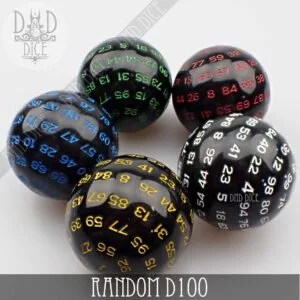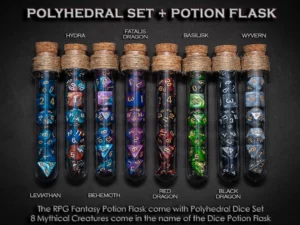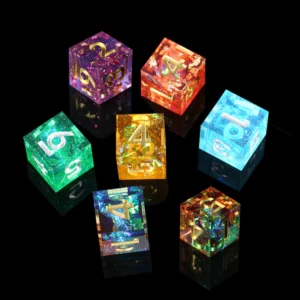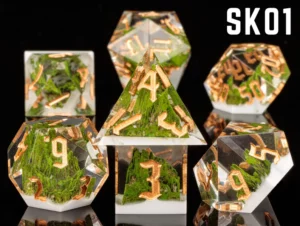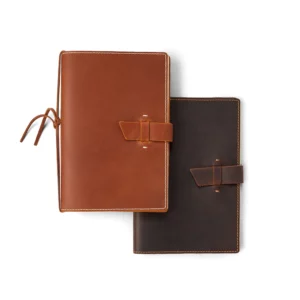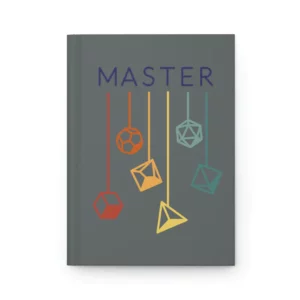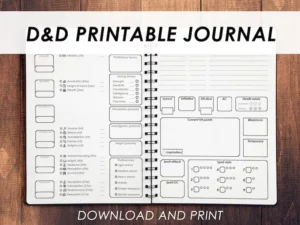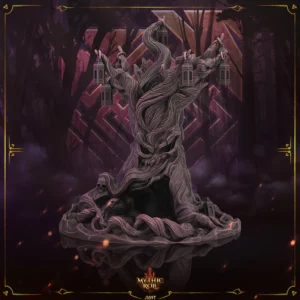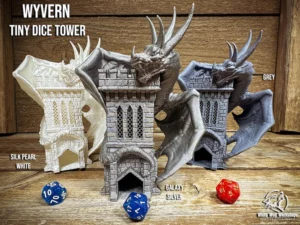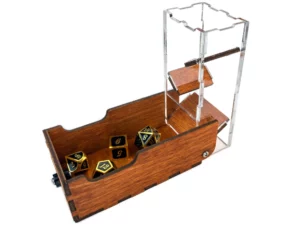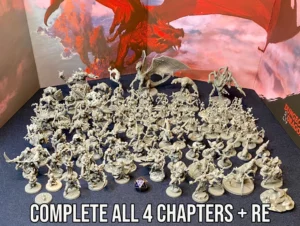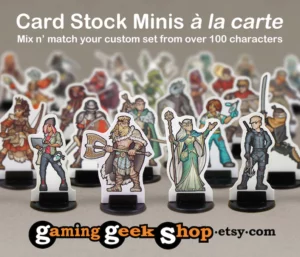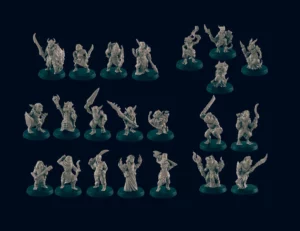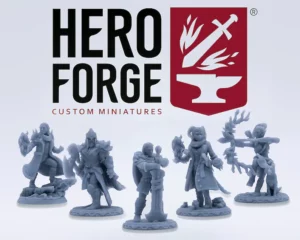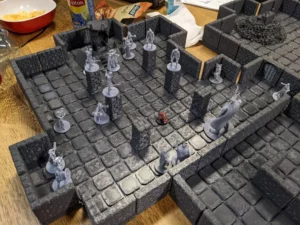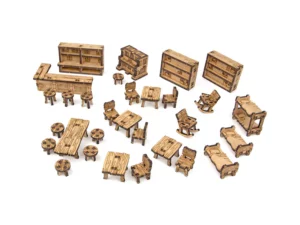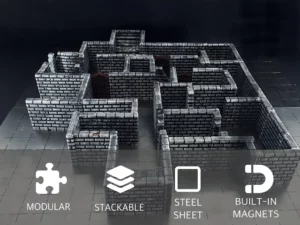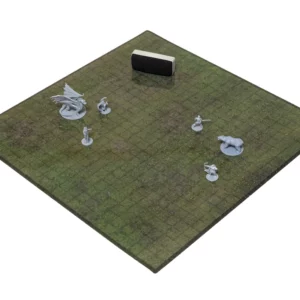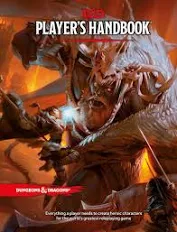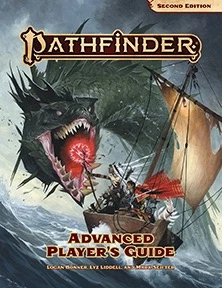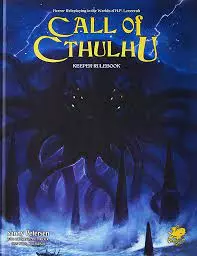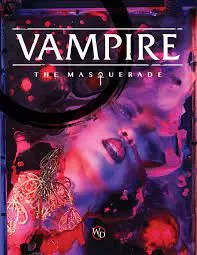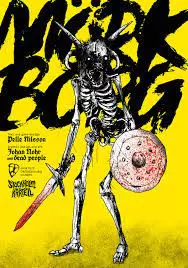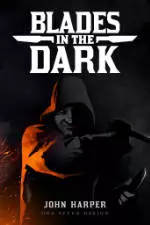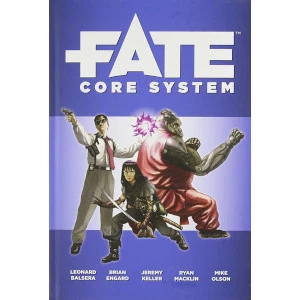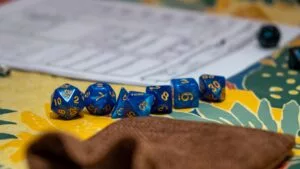
Tabletop Gaming: An Introduction
It’s a 50-year-old genre of gaming. Yet, despite the genre’s longevity, tabletop role playing games (TTRPG) are enjoying a continued renaissance of popularity that seems to reach higher heights. Since the boys from Stranger Things sat down at their table in Episode 1 to play D&D, and during the pandemic when people had more time than they knew what to do with, TTRPGs have seen a continual growth in popularity.
Even now, in 2024, the intellectual property of many TTRPGs has been been the heart of blockbuster movies, AAA video game releases, popular animated TV series, and streaming content, with more coming on the horizon.
Many have gotten into the hobby within the last decade, and this continual growth seems steady as many communities welcome new players. But where to start? If you are a prospective new player, look no further than this guide.
What is a TTRPG?
Tabletop role playing games are most often defined as narrative strategy games where the players take on the role of characters in the story. Some defining characteristics of most TTRPG include the following:
- The focus on collaborative, cooperative gameplay and storytelling.
- Playing from the perspective of a protagonist of the player’s own creation.
- The presence of a “GM” or game master who functions in a sort of game designer / referee role, providing challenges for the players.
These aspects crucially distinguish this genre from other type of tabletop gaming including boardgames. Other aspects, like playing within the “theatre of the mind” of an imagined game space, using dice as a main resolution mechanic, and playing over multiple sessions, are classic traits that distinguish TTRPG’s, but are not universal.
The styles of TTRPG
Every TTRPG is different, in gameplay mechanics and design philosophy, to the kind of scope and setting of the world the game exists in. While setting is probably the most obvious, it can be hugely influential to the other aspects of the game. Scope refers to specifically the depths of gameplay, or how “crunchy” a system is. This puts a slight barrier of entry, but can also provide deeper gameplay.
Game theorists have considered different games falling under three different styles between Simulationist, Gamist, and Narrativist, which while blurred since the early days of the concepts, still provide some sense of guidance to find a game.
Simulationism is the attempt to simulate an experience more closely than other forms of TTRPGs. This often comes with a crunchy system with lots of rules designed to maintain verisimilitude within the game world while playing. Game systems like G.U.R.P.S. and Fudge offer genre-ambivalent systems that can provide simulationist experiences across many genres, while Call of Cthulhu provides a simulationist approach to the insanity of cosmic horror.
Gamism reflects the ideals within gaming, with the main goal to create a fun game to play beyond the other aspects. Immersion and narrative take background roles in contrast to the in-game challenges. D&D 4th edition was a classic form of gamism, due to it’s focus on balance and in-game options for each player to employ.
Narrativism focuses on the act of collaborative story telling, and primarily narrativist games can be the simplest games as the game emphasizes storytelling and includes game mechanics that allow for spontaneity and creative flexibility, making them great for new players. Games like Blades in the Dark exemplify this style of game.
These styles exist along a spectrum, with different games having different amounts of all three elements to some extent, but typically prioritize one over the other.
Why play TTRPGs
Tabletop games are an entirely different gaming experience, even compared to other kinds of RPGs.
The embrace of the “role-playing,” letting players imagine themselves as the characters they made, enables for an alternative RPG experience that feels more attached and connected.
Role-playing can add a surprising amount of depth to the character creation process and storytelling, and the interplay between GM and player in how the story comes together means that storytelling can often be open-ended and surprising. As a group activity, it can be a fun, with endless hijinks or epic moments. I catch myself reminiscing about fictional moments my fictional character achieved, even now.
Of course, you should only roleplay as much as you are comfortable with. Some tables are going to get into the gamist and simulationist aspects of these games, and that’s totally understandable! The main point is there are many reasons you might enjoy playing a TTRPG, and likely there’s a game out there that suits you.
Where to get started
Where to get started
Oftentimes, getting started with playing a TTRPG can be the hardest part. While the communities are growing, it has never been a surefire thing to find a group, especially one that fits your gaming sensibilities. Here are some steps you can take to get playing.
Find a group – First of all, you will need to find who you are going to play with, including figuring out who will GM. Whether this means recruiting some friends or finding a local table through a board game café or a library, you need to play with someone else, even if just for a one-on-one game. We expand more on this plight in the next section.
The rules – In my first D&D game I played, my understanding of the rules came down to the brief explanations of the DM. This was a big mistake. Years later when I was clearing out my parents house, I found my character sheet and, well, my Warlock had 11 Charisma (that’s not good). The rulebooks can be huge but it is not necessary to read it all: skimming and watching some YouTube videos is likely the best place to start to familiarize yourself.
Really learn the rules (if you are the GM) – Yeah, you should know the rules more than we detail in the first bullet point. As a referee for many of the game mechanics, the GM should familiarize themselves with certain aspects of the game, like familiarizing yourself to the language used in the rules and knowing the basics of the game. You do not need an expansive knowledge (the internet is an excellent resource) but it is hard to play at a table where the DM’s inexperience slows the game down. At the end of the day, GM’s rulings are the rulings.
A session Zero – Session zero is a term in which prospective players meet to discuss what the future game will be like. It is important as it lets both players and game master communicate and set up expectations and boundaries for the future gaming sessions, as well as establish the narrative of the future game.
This helps prevent conflict or miscommunication down the road, and helps establish your gaming group. You can use this time to make fun plans with your characters too.
A time to play – Once you have established a group and all the information, now you just need to find a time to play! This includes figuring where you are playing, especially if playing an in-person game. Always give others a heads up as soon as possible if you are unable to make a session – most games will continue with a player missing, handwaving their absence most of the time in-game.
LFG: Finding a game
The majority of Tabletop RPG’s function best with a small group of players, but ideally between 4-7, including the game master. Like many boardgames, the number to optimally play can be difficult to some whose friends and family are either not interested in the games, or have busy schedules.
There are other ways that you can find a group to play. Local games stores and libraries are often great places to start looking for a game, and if you are near a large enough population, you can find a home game through community channels including social media including Facebook, Reddit, Discord,
Additionally, since the pandemic, digital tabletops have exploded, letting players meet up from across the world to play TTRPGs together. This is the premier way people play DND online now, and so people can play with friends from across the world, or play with people they have never met before. Some popular digital tabletops include:
Why game master a TTRPG
The lack of a game master or “dungeon master” as they are very frequently called is one of the biggest obstacles for playing tabletop games. In fact, the presence of the game master is a very fundamental distintion between board games and tabletop role playing games.
Many people get into the hobby through people who already play. This way is great, as it helps learning as a new player, as well as introduces you to different aspects without being dry or bogging down the process. Not everybody wants to read a book before they play (but I still recommend you do so).
However, in the absence of a sagely Game Master, getting a game together can be a difficult task to manage. Becoming the DM can be a great way to ensure you and your friends or gaming group can play, as well as offering a completely different side to TTRPG gameplay.But it can be a lot of work.
Since the duties of the dungeon master are more involved, it takes much more time knowing the system of the TTRPG and the adventure you will run.
However, there are many adventure books or PDFs available for that make running an adventure much easier.
We called Gloomhaven a perfect substitute for this type of game for those who do not have access to a DM. More on boardgames here.
Enhancing your game with extras
Once you get the itch for tabletop gaming, it can quickly become a hobby you can put a lot of time into. While theatre of the mind can be a great place to start from, after playing for some time, groups typically either migrate to virtual tabletops or enhance the experience through the use of battle maps, terrain, and miniatures.
When our table began using miniatures and a grid to visualize the battlefield, the engagement level went up among all players, things like movement or range in the game became tangible, and the overall game became more fluid and easier to pay attention to.
Miniatures (both painted and unpainted), tokens, or other small game pieces can be a stand-in for any character or monster, and using props or special terrain to make your battlemaps improve the dynamism of combat.
If you are looking to improve engagement and immersion at your table, the following extras might be worth your time.
Dice
Character Journal
Dice Towers
Miniatures
Terrain
A brief introduction to many great games
There are so many TTRPGs out there that it might be daunting to know where to start. So we have put together a list of the internet’s favourite games (excluding those based on established intellectual property) so you can familiarize yourself with the major players.
Keywords:
D20 systems: Named for the use of a 20-sided die for their resolution mechanic. Similarly, any system that uses a die will be distinguished by discussing the size of dice it uses.
Dungeons & Dragons (5th Edition)
Or commonly referred to by DND, is the biggest of the group. Dungeons and Dragons is the longest running table top gaming franchise, with it’s very first iteration coming out almost fifty years ago in 1974.
Dungeons and Dragons is a high-fantasy adventure game structured around combat primarily. It attempts to be setting agnostic, meaning that the game system is divorced from the game world, and with multiple pre-built worlds and the ability to create your own, can be a very open game to your DM’s creative whims.
D&D, like many other long standing game systems, has a number of different rulesets under different editions. Current edition if 5th addition, although 5th edition is currently seeing some adjustments and rule changes being playtested under a 50th anniversary initiative called One D&D. While the majority plays the current edition, 3rds or 3.5 edition is another common edition played, and is popular among many long-time players.
D&D is a d20 system, meaning at the very minimum, you will probably need a d20 dice set (one per player is ideal) and the rules. Other than that, everything else is an extra or a quality-of-life improvement.
Pathfinder (2nd edition)
The other monster of the fantasy dungeon-crawl genre, Pathfinder is a hugely popular d20 system.
Similar in ways to D&D, since it broke off from the game after 3rd edition under the Open Game License (OGL). While Pathfinder’s origins come from 3.5 D&D, these day’s the system has included plenty of its own innovations and mechanics that lead many seasoned TTRPG gamers to the system.
What’s the difference between them, then? Primarily the game’s philosophy. Pathfinder is simultaneously a crunchier, rule-heavy game that tries to make the game easier for the DM by giving concrete answers and rulings. DND 5E on the other hand relies on DM rulings and subjective interpretations of the rules sometimes.The writers and game designers understand the crunch of the being dungeon master, with strong resources available to both dm and player and a more balanced system overall.
However, long feature chains and a more involved character creation process can be both a benefit or a negative to this system – long time TTRPG players love this in-depth character creation process, but newer players might be stumped with analysis paralysis.
Pathfinder is the game I would recommend for established TTRPG players who want to move onto another system but also don’t want to lose the high-fantasy or setting-agnostic aspects of the game.
Call of Cthulu (7th edition)
Horror RPGs are a well-established tradition at this point. Unfortunately, it can be very hard to run an authentic horror experience in many systems. Call of Cthulhu is a system designed for exploring the unknown and unknowable, as you tackle horrifying Eldritch horror experiences based on the cosmic horror of writers including H.P. Lovecraft (without any of the problematic baggage).
The game feels very well suited for it’s style of investigative horror. Call of Cthulhu is a system with simulative slant to it with features plenty of immersive mechanics from good (Luck) to bad (Sanity) which grant your decisions extra complication and consequence – like going mad after witnessing an unfathomable entity.
The game is not scary in a sense of beginning either – the game’s mechanics aren’t crunchy. The list of rolls or skills you can use to investigate strange occurrences that have been happening is intuitive and not too complicated. Problems often have multiple ways to solve them. Since it’s a d100 system, you have to approach the game differently – since the die rolls are expressed as percentages, it might feel foreign at first if you are coming from d20 systems.
The game ‘s included adventure feels true to a Lovecraftian short story and the resources available lets prospective GM’s really revel in the horror. While not as open an experience as some other Horror-centric games, the investigative angle provides a reliable thread for repeated play, and the system’s overall friendliness puts this system above the others if you want to spook yourself at the gaming table.
Vampire: the Masquerade (5th Edition)
Another horror-inspired game set in an alternate fantasy earth, Vampire the Masquerade looks back to the classic elements of Gothic Horror of the world of vampires and all other kinds of undead. Playing AS a vampire in this game, you have to navigate the world against clans of plotting vampires or other monsters, while quenching your vampiric thirst.
VtM is a a d10 system where the basis of the game is developed through scheming to nefarious ends. The DM, or in this system, the “Storyteller” describes the world and calls for rolls. The setting of the game includes super powerful vampire hierarchies and all other kinds of gothic references. Think more Blade or Anne Rice than Castelvania or Dracula.
A character in Vampire the Masquerade has clans instead of classes, vampiric bloodlines that determine appearance and disciplines, which are specific powers and abilities granted by the Clan. But it’s not all good: each clan has a bane that affects them uniquely, as well as a Compulsion which is a consequence of a certain kind of failure.
Darker in its nature due to themes including murder and coercion, the game’s scheming nature rather than it’s focus on combat makes this game skew for a more mature audience of ttrpg player.
Mork Borg
An apocalyptic horror game with a nihilistically hopeless black metal aesthetic, if that did not sell you on the following game than perhaps your weak of heart. Mork Borg is a rules light d20 game that recalls OSR style gameplay with a grimdark flair. The name means “Dark Castle” in it’s native Swedish and even has an official soundtrack in the form of a doom metal playlist. You gotta admit that’s pretty cool.
Playing as lost souls, your characters try to survive in the bleak world while a basilisk’s premonitions for the apocalypse ring true, invariably getting dragged into dungeon crawls until they eventually succumb. In many ways, it stays true to some of the great classic motifs and cliches while being brutal yet friendly to all players. The resources for gameplay are easy and have all the random tables you could want, making planning a session as simple as a few clicks of the button in DNGNGEN, Mork Borg’s official dungeon creator.
Monster stat lines are often less than a sentence long, and the entire description of one is not longer than a paragraph. Whole dungeons can be found on a single sheet of a PDF. Best of all, the game comes with Third Party License that lets creators homebrew their own content for the game and distribute it for free or for income without needing to worry about the legality.
Bonus: Pirate Borg has been fully funded on kickstarter, so look for it to hit the seas soon!
Gumshoe
For running investigative roleplaying adventurers with countless of modules across dozens of genres, the Gumshoe system is a strong contender. From hardboiled noir to eldritch horror, spy intrigue and super-heroic capers, it’s a simple and easy system, yet rewards player thinking and skill.
The idea behind the game is simple: some event triggers the player’s investigation into what happened, and slowly your characters uncover the sinister conspiracy by following the breadcrumb trail of clues found in the locales the mystery leads you to.
Gumshoe is a d6 system, making getting into playing super easy with minimal barriers Described like being similar to a “traditional” RPGS (but not OSR, mind you) with a few things that make it unique. Modern touches added to speed up the gameplay.
The other main mechanics include a Point Pool to help improve your chances of succeeding and lists of “Expansion skills” which grant clues in each local if you have the right skill.
One mechanical issue you can see in some TTRPG’s is investigation can halt as soon as a player becomes unlucky on a roll. In a situation like combat, mssing a roll is not a big deal, but if missing the roll means missing a clue, then you can have players spinning their wheels with nowhere to go narratively. The design of Gumshoe counters that. Still, the list of skills is quite large depending on the system, which is the biggest stumbling block that players cited.
Like many of the genre ambiguous systems, Gumshoe has plenty of reskins to fit your favourite genres, meanng there’s like a Gumshoe book ready for all kinds of investigative narratives:
Nights Black Agents investigates a post-Cold War vampire conspiracy, Mutant City Blues is a hybrid of Superheroes and the police investigation genre, and Esoterrorists involves investigating occult cultists terrorizing your town.
Blades in the Dark
The more you get into RPG communities on the web and IRL, there seems to be a consensus that the best systems are specialized to be the best in a certain style of game or narrative. For a system that is dialed-in to the heist genre, and that is exceptional at extended play, look to Blades in the Dark.
Blades in the Dark is a game where setting is dark and gritty and so are your characters (keep in mind, heroes-at-heart), with elements of dieselpunk while still within the realm of the fantastical.
The game system of Blades of the Dark is wholly unique, with many interesting mechanics that while being somewhat crunchy, does not feel rules restrictive on the players. Stress mechanics, flashbacks, bargains – all unique elements that let you get the roleplaying action going. However, this does not reflect on the GM’s job, as fans of running this game find the planning easy as it’s based on the rolls of the dice. Stress mechanics, bargains, flashbacks
There are some hang-ups some gamers listed, as it is strikingly different from some of the other most popular games. BitD requires players to buy into the “Collaborative acting” side of an RPG far more than more mainstream systems do, where the world and its environments is a negotiation between the GM and the players about the aspects of the world, and not just interact with the world the DM provides them.
This stays in line with it’s Anti-OSR vibe, as it goes against many of the conventions that many trad games introduce. Consider the difference: Do you want to explore the GM’s world and go along with the ride, or are you down to contribute to your own slice of the fantasy each session? If the latter is a yes, BitD is worth checking out.
While the game is not really ambiguous – it is a heist RPG system after all, there are versions of the game that might intrigue players, known as “Forged in the Dark” games. Scum & Villany brings the heist into space for a space heist a la Star Wars, while Band of Blades brings you into a dark militaristic fantasy setting.
Fate
One of the behemoths of the genre, Fate has its loyalists Since it broke onto the scene all the way back in 2003. This Open-ended narrative building system is famous for being able to handle almost any genre or style of game.
It was close between Fate or GURPS for which system to include on this list among those that provide the kind of blank slate that you can create anything with. In the end, we favoured with the more narrativist style game as opposed to the crunchy simulationist gameplay you would get with G.U.R.P.S.
Fate is good at giving freedom to its players, as the style of roleplaying in the system relies on a collaborative, improvisational authorship where everybody’s decisions matter in the game world. However, in Fate, the decision-based meta-narrative style of game can be more detached than other systems: one user said: “You don’t so much play as your PC, as take the role of a director or author in a group of directors and authors”. There’s more emotional distance, yet the narratives can be
This type of authorship can lend Fate to a pulpier style of gameplay (expected, since there’s a literal Gorilla with mechanical arms on the cover of the core rules), so optimally there needs to be a certain amount of player buy-in for each game.
Fate games can sometimes feel rules-lite, with a relative mechanical ease compared to some games, but there can be a number of rules to account for when playing, especially taking into account the core system itself, and the setting module which might add new mechanics into the game’s chassis. There are cool core mechanics including the aspect mechanic, a free-form descriptor of something notable about either the game, the character, or the scene, that grant bonuses, as well as stunts that give your characters inherent boosts to different skills you can access.
However, there are aspects to the system that might not be to your groups liking, especially coming form the common “gateway drugs” of TTRPGS. The stunt system for one has been accused of being unbalanced, but not all games need meticulous balance (note: GURPS is very balanced but has the complexity to make it so) Also, combat is not really something FATE is designed for. Also, the dice are Fudge dice- the only system on this list that uses a 3-value d6 – so you will likely need to buy dice for FATE too.
Frequently Asked Questions
Why play Tabletop RPGs?
While certainly not for everyone, Tabletop role playing games offer an unparalleled form of gaming in terms of immersion and agency in the story telling. Combining the episodic narrative storytelling like you see on TV with an immersive RPG game play experience means you can feel like you were there.
Some games are a vicarious power fantasies, some are horrifying, high-stakes rabbit holes, and some are non-threatening romps with friends – whatever you are into, there’s a TTPRG targeted for you.
Why DM TTRPGs?
There seems to be some discourse online that being the dungeon master is a thankless duty. But I do not think this is the case.
While being a DM is inherently more work than playing as a PC, you don’t need to put more than a few hours between sessions planning, if that, depending on how your approach game mastering.
There are two common ways that people DM.
The first is using pre-written material, either from the game designers or some other 3rd party. This helps in a lot of ways. By providing a balanced adventure, most of the work comes from knowing the content and planning it out for each session, instead of learning how the system works inside and out which is required to create strong encounters.
The second is using content you create yourself, from material found in other sources, as well as custom created content called “Homebrew” by the community at large. This requires knowing and following the system, as homebrew can absolutely destroy any semblance of balance if it is not done right.
So, let’s get back to the question at hand: why DM? Being the dungeon or game master gives you a completely different role and responsibilities that can equally as fun. Your role in controlling the world around the characters, including filling it with challenges, enemies o, lets you throw your players in scenarios that seem interesting to you, as well as lets you play as a variety of creatures or enemies.
What is some TTRPG etiquette?
With anything with a big community, there has developed some TTRPG etiquette that when subscribed to will ensure a fun game is had by all. Here is some commonly discussed etiquette online that will help foster a positive gaming mechanic.
–There are stakes. Keep that in the forefront of your mind, and understand that your actions may have consequences that can change the game.
-You are not the main character. Nobody is more important in the campaign than anyone else. You might have an arc or story you want to tell, but let others get the spotlight too.
-Work together to solve problems, as being adversarial only creates problems. Don’t fight player versus player, PVP as it is called is usually a waste of time for everyone else.
-Avoid behaviour or content that will make any player uncomfortable. Not sure if it’s uncomfy territory? Talk it out!
-The DM’s role is not to be adversarial, but to challenge the party with an engaging problem. A good DM challenges the party but not too much, and leaves fate up to the dice.
How long do you play?
1 hour is often not enough to get through a session because of how much time aspects like roleplay last, especially if you are having fun. Between two to four hours is a healthy number, with breaks at times. Consider the game is turn based. This means you should not only pay attention to what is going on when its not your turn, but you should be planning your future moves ahead of time.
You can play more, but games tend to be more draining than video games because of the immersion they ask.
In terms of how many sessions you will play… that is a whole different story. Some games last for years without coming to an end, and some fall apart quickly. I recommend start thinking smaller rather than bigger, as most campaigns do not last more than 5 sessions.
Read more

The Best Guitar Picks in Canada
A good guitar pick is essential for any guitar player.

The Best Guitar Strings in Canada
Guitar strings are integral to how a guitar sounds and plays. Choose the best strings for your axe here.

The Best Acoustic Guitars At Any Price
Playing music is a fun and rewarding hobby. This buying guide lists the best acoustic guitars available.

The Best Karaoke Software
Party like it’s 1999 with karaoke!
